Holly Thompson's Blog, page 33
June 20, 2012
Heading to ALA Anaheim for the APALA Award Presentation
I'm packing my bags for the U.S., and my first stop is ALA Anaheim!

On Saturday, June 23, I'll be wandering the exhibition floors, catching some author talks, and pre-signing copies of Orchards at the Random House booth (#2511).
On Sunday morning, June 24, I'll be at the APALA Asian/Pacific American Awards presentation and will give a brief speech.

Time to pack! Maybe see you there...

On Saturday, June 23, I'll be wandering the exhibition floors, catching some author talks, and pre-signing copies of Orchards at the Random House booth (#2511).
On Sunday morning, June 24, I'll be at the APALA Asian/Pacific American Awards presentation and will give a brief speech.

Time to pack! Maybe see you there...
Published on June 20, 2012 21:54
June 19, 2012
After the Typhoon--Beach Houses on Hold
Yesterday, typhoon #4 tracked across Kanto. The wind gusts slammed so hard they felt like earthquakes, and Kamakura's coastline was hit hard, wreaking havoc for fishing families and wakame growers.
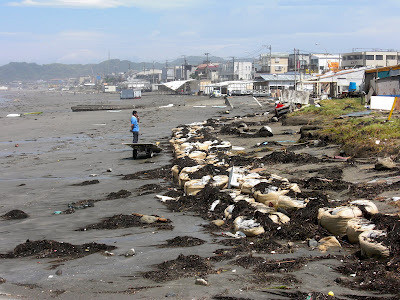 The timing of this early typhoon couldn't have been worse for the owners and managers of the temporary umi no ie or beach houses--the summer restaurants that are built right on the beach just for the summer swim season.
The timing of this early typhoon couldn't have been worse for the owners and managers of the temporary umi no ie or beach houses--the summer restaurants that are built right on the beach just for the summer swim season.

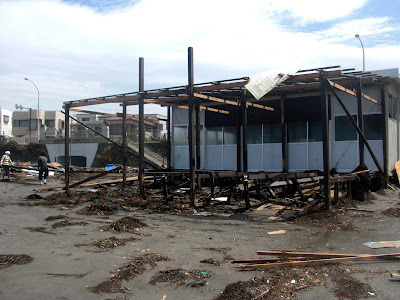
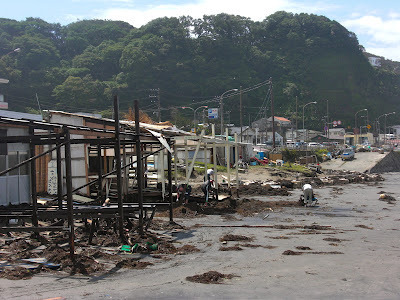
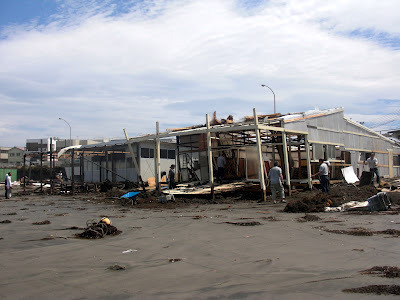 There was major damage to many of the umi no ie. Heaps of seaweed, construction materials and debris lie everywhere, and there is much clean-up work to do before reconstruction can begin. Hmm, perhaps it's time for the city to rethink this idea of building, even on a temporary basis, directly on the beach.
There was major damage to many of the umi no ie. Heaps of seaweed, construction materials and debris lie everywhere, and there is much clean-up work to do before reconstruction can begin. Hmm, perhaps it's time for the city to rethink this idea of building, even on a temporary basis, directly on the beach.
One truck driver had clearly picked the wrong time and place to make a delivery or pick-up--apparently during the typhoon.
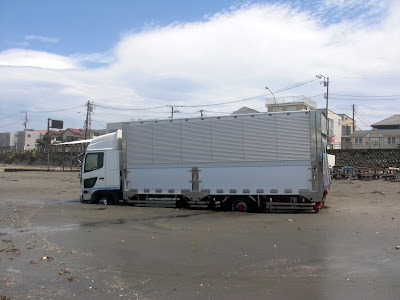 The wind this morning is salty and blowing at sand-pelting speeds, which always brings out the crazy wind surfers.
The wind this morning is salty and blowing at sand-pelting speeds, which always brings out the crazy wind surfers.

And the clouds are ever shifting.
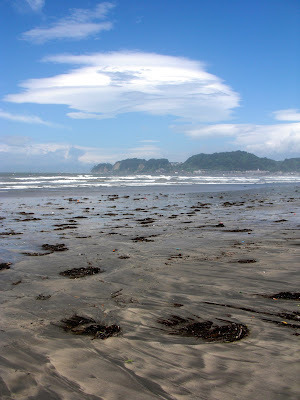 So now that I've desalted the windows, the car, the laundry balcony, the garden, we can get ready for the typhoon #5...due to hit Japan tomorrow.
So now that I've desalted the windows, the car, the laundry balcony, the garden, we can get ready for the typhoon #5...due to hit Japan tomorrow.
 The timing of this early typhoon couldn't have been worse for the owners and managers of the temporary umi no ie or beach houses--the summer restaurants that are built right on the beach just for the summer swim season.
The timing of this early typhoon couldn't have been worse for the owners and managers of the temporary umi no ie or beach houses--the summer restaurants that are built right on the beach just for the summer swim season.


 There was major damage to many of the umi no ie. Heaps of seaweed, construction materials and debris lie everywhere, and there is much clean-up work to do before reconstruction can begin. Hmm, perhaps it's time for the city to rethink this idea of building, even on a temporary basis, directly on the beach.
There was major damage to many of the umi no ie. Heaps of seaweed, construction materials and debris lie everywhere, and there is much clean-up work to do before reconstruction can begin. Hmm, perhaps it's time for the city to rethink this idea of building, even on a temporary basis, directly on the beach.One truck driver had clearly picked the wrong time and place to make a delivery or pick-up--apparently during the typhoon.
 The wind this morning is salty and blowing at sand-pelting speeds, which always brings out the crazy wind surfers.
The wind this morning is salty and blowing at sand-pelting speeds, which always brings out the crazy wind surfers.
And the clouds are ever shifting.
 So now that I've desalted the windows, the car, the laundry balcony, the garden, we can get ready for the typhoon #5...due to hit Japan tomorrow.
So now that I've desalted the windows, the car, the laundry balcony, the garden, we can get ready for the typhoon #5...due to hit Japan tomorrow.
Published on June 19, 2012 20:28
June 16, 2012
My New Verse Novel--The Language Inside
This has been an intense June so far, with a heavy dose of bookmap homework on a new novel due in advance of the SCBWI Tokyo Writers' Retreat in Gotemba June 8-10; the SCBWI Tokyo Translation Day 2012--Bringing Japanese Teen Literature to the World on June 16; and the final editing of my new YA verse novel The Language Inside.
At last, I"m happy to reveal the cover of The Language Inside.
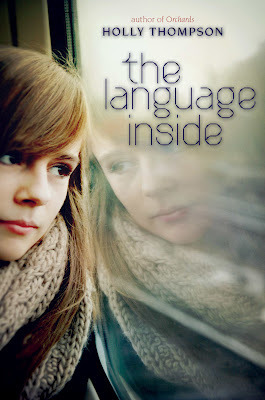
And the flap copy:
<!-- /* Font Definitions */ @font-face {font-family:Times; panose-1:2 0 5 0 0 0 0 0 0 0; mso-font-charset:0; mso-generic-font-family:auto; mso-font-pitch:variable; mso-font-signature:3 0 0 0 1 0;} @font-face {font-family:"MS 明朝"; mso-font-charset:78; mso-generic-font-family:auto; mso-font-pitch:variable; mso-font-signature:1 134676480 16 0 131072 0;} @font-face {font-family:"Cambria Math"; panose-1:2 4 5 3 5 4 6 3 2 4; mso-font-charset:0; mso-generic-font-family:auto; mso-font-pitch:variable; mso-font-signature:-536870145 1107305727 0 0 415 0;} @font-face {font-family:Cambria; panose-1:2 4 5 3 5 4 6 3 2 4; mso-font-charset:0; mso-generic-font-family:auto; mso-font-pitch:variable; mso-font-signature:-536870145 1073743103 0 0 415 0;} /* Style Definitions */ p.MsoNormal, li.MsoNormal, div.MsoNormal {mso-style-unhide:no; mso-style-qformat:yes; mso-style-parent:""; margin:0cm; margin-bottom:.0001pt; mso-pagination:widow-orphan; font-size:12.0pt; font-family:Cambria; mso-ascii-font-family:Cambria; mso-ascii-theme-font:minor-latin; mso-fareast-font-family:"MS 明朝"; mso-fareast-theme-font:minor-fareast; mso-hansi-font-family:Cambria; mso-hansi-theme-font:minor-latin; mso-bidi-font-family:"Times New Roman"; mso-bidi-theme-font:minor-bidi;} .MsoChpDefault {mso-style-type:export-only; mso-default-props:yes; font-family:Cambria; mso-ascii-font-family:Cambria; mso-ascii-theme-font:minor-latin; mso-fareast-font-family:"MS 明朝"; mso-fareast-theme-font:minor-fareast; mso-hansi-font-family:Cambria; mso-hansi-theme-font:minor-latin; mso-bidi-font-family:"Times New Roman"; mso-bidi-theme-font:minor-bidi;} @page WordSection1 {size:612.0pt 792.0pt; margin:72.0pt 90.0pt 72.0pt 90.0pt; mso-header-margin:36.0pt; mso-footer-margin:36.0pt; mso-paper-source:0;} div.WordSection1 {page:WordSection1;} - </style><span style="font-size: small;"><span style="font-family: Times;">Emma Karas was raised in Japan; it’s the country she calls home. But when her mother is diagnosed with breast cancer, Emma’s family moves to a town outside Lowell, Massachusetts to stay with her grandmother while her mom undergoes treatment.</span></span></div><div class="MsoNormal" style="color: #0b5394;"><br /></div><div class="MsoNormal" style="color: #0b5394;"><span style="font-size: small;"><span style="font-family: Times;">Emma feels out of place in the United States, begins to have migraines, and longs to be back in Japan. At her grandmother’s urging, she volunteers in a long-term care center to help Zena, a patient with </span><span style="font-family: "Times New Roman";">locked-in syndrome, write down her poems. There, Emma meets Samnang, another volunteer, who assists elderly Cambodian refugees. Weekly visits to the care center, Zena’s poems, dance, and noodle soup bring Emma and Samnang closer, until Emma must make a painful choice: stay in Massachusetts, or return early to Japan.</span></span></div><span style="font-size: small;"><i> </i></span><br />And the full jacket design:<br /><br /><div class="separator" style="clear: both; text-align: center;"><a href="http://2.bp.blogspot.com/-JTkMdDTXnlw..." imageanchor="1" style="margin-left: 1em; margin-right: 1em;"><img border="0" height="171" src="http://2.bp.blogspot.com/-JTkMdDTXnlw..." width="400" /></a></div><br />Thank you to my editor Francoise Bui at Delacorte/Random House. <i>The Language Inside </i>is due out in March 2013. ARCs coming soon!<div class="blogger-post-footer"><img width='1' height='1' src='https://blogger.googleusercontent.com...' alt='' /></div>
At last, I"m happy to reveal the cover of The Language Inside.

And the flap copy:
<!-- /* Font Definitions */ @font-face {font-family:Times; panose-1:2 0 5 0 0 0 0 0 0 0; mso-font-charset:0; mso-generic-font-family:auto; mso-font-pitch:variable; mso-font-signature:3 0 0 0 1 0;} @font-face {font-family:"MS 明朝"; mso-font-charset:78; mso-generic-font-family:auto; mso-font-pitch:variable; mso-font-signature:1 134676480 16 0 131072 0;} @font-face {font-family:"Cambria Math"; panose-1:2 4 5 3 5 4 6 3 2 4; mso-font-charset:0; mso-generic-font-family:auto; mso-font-pitch:variable; mso-font-signature:-536870145 1107305727 0 0 415 0;} @font-face {font-family:Cambria; panose-1:2 4 5 3 5 4 6 3 2 4; mso-font-charset:0; mso-generic-font-family:auto; mso-font-pitch:variable; mso-font-signature:-536870145 1073743103 0 0 415 0;} /* Style Definitions */ p.MsoNormal, li.MsoNormal, div.MsoNormal {mso-style-unhide:no; mso-style-qformat:yes; mso-style-parent:""; margin:0cm; margin-bottom:.0001pt; mso-pagination:widow-orphan; font-size:12.0pt; font-family:Cambria; mso-ascii-font-family:Cambria; mso-ascii-theme-font:minor-latin; mso-fareast-font-family:"MS 明朝"; mso-fareast-theme-font:minor-fareast; mso-hansi-font-family:Cambria; mso-hansi-theme-font:minor-latin; mso-bidi-font-family:"Times New Roman"; mso-bidi-theme-font:minor-bidi;} .MsoChpDefault {mso-style-type:export-only; mso-default-props:yes; font-family:Cambria; mso-ascii-font-family:Cambria; mso-ascii-theme-font:minor-latin; mso-fareast-font-family:"MS 明朝"; mso-fareast-theme-font:minor-fareast; mso-hansi-font-family:Cambria; mso-hansi-theme-font:minor-latin; mso-bidi-font-family:"Times New Roman"; mso-bidi-theme-font:minor-bidi;} @page WordSection1 {size:612.0pt 792.0pt; margin:72.0pt 90.0pt 72.0pt 90.0pt; mso-header-margin:36.0pt; mso-footer-margin:36.0pt; mso-paper-source:0;} div.WordSection1 {page:WordSection1;} - </style><span style="font-size: small;"><span style="font-family: Times;">Emma Karas was raised in Japan; it’s the country she calls home. But when her mother is diagnosed with breast cancer, Emma’s family moves to a town outside Lowell, Massachusetts to stay with her grandmother while her mom undergoes treatment.</span></span></div><div class="MsoNormal" style="color: #0b5394;"><br /></div><div class="MsoNormal" style="color: #0b5394;"><span style="font-size: small;"><span style="font-family: Times;">Emma feels out of place in the United States, begins to have migraines, and longs to be back in Japan. At her grandmother’s urging, she volunteers in a long-term care center to help Zena, a patient with </span><span style="font-family: "Times New Roman";">locked-in syndrome, write down her poems. There, Emma meets Samnang, another volunteer, who assists elderly Cambodian refugees. Weekly visits to the care center, Zena’s poems, dance, and noodle soup bring Emma and Samnang closer, until Emma must make a painful choice: stay in Massachusetts, or return early to Japan.</span></span></div><span style="font-size: small;"><i> </i></span><br />And the full jacket design:<br /><br /><div class="separator" style="clear: both; text-align: center;"><a href="http://2.bp.blogspot.com/-JTkMdDTXnlw..." imageanchor="1" style="margin-left: 1em; margin-right: 1em;"><img border="0" height="171" src="http://2.bp.blogspot.com/-JTkMdDTXnlw..." width="400" /></a></div><br />Thank you to my editor Francoise Bui at Delacorte/Random House. <i>The Language Inside </i>is due out in March 2013. ARCs coming soon!<div class="blogger-post-footer"><img width='1' height='1' src='https://blogger.googleusercontent.com...' alt='' /></div>
Published on June 16, 2012 23:49
May 30, 2012
Global Voices Part 3: Children's and YA Books in Translation from Japan
 Recently PaperTigers.org, the wonderful website that focuses on multicultural books for young readers, world literacy and more, launched a series on the PaperTigers Blog called Global Voices. I was honored to be asked to be the first guest blogger for this new program. The PaperTigers Blog describes the new Global Voices program: "Each month we will be inviting a guest to join us and write three blog posts. The posts will be published on three consecutive Wednesdays within each month under the title “Global Voices”. Our guests, located around the world, are all involved in the world of kid and YA lit and include award winning authors and illustrators, bloggers, librarians, educators and more! It is our hope that through the Global Voices posts we can better highlight the world of multicultural kid lit and YA lit in different countries around the world."
Recently PaperTigers.org, the wonderful website that focuses on multicultural books for young readers, world literacy and more, launched a series on the PaperTigers Blog called Global Voices. I was honored to be asked to be the first guest blogger for this new program. The PaperTigers Blog describes the new Global Voices program: "Each month we will be inviting a guest to join us and write three blog posts. The posts will be published on three consecutive Wednesdays within each month under the title “Global Voices”. Our guests, located around the world, are all involved in the world of kid and YA lit and include award winning authors and illustrators, bloggers, librarians, educators and more! It is our hope that through the Global Voices posts we can better highlight the world of multicultural kid lit and YA lit in different countries around the world."You can read Part 1 of my three-part series here and Part 2 here.
In my Global Voices post Part 3 I share my thoughts on children's and YA books in translation from Japan. I also offer links to books and publishers and the SCBWI Tokyo Translation Group.
Please have a look at the post and add your comments. Recommend your favorite children's, MG and YA Japanese books in translation!
Thanks to the interest in manga and anime worldwide, there is a bit more interest in Japanese fiction for teens these days. I'm especially hoping to discover more and more Japanese YA novels in translation in the coming years.
Published on May 30, 2012 19:44
May 24, 2012
Global Voices Part 2: English-language Asia-set Children’s and YA Fiction
Last week PaperTigers.org, the wonderful website that focuses on multicultural books for young readers, world literacy and more, launched a series on the PaperTigers Blog called Global Voices. I was honored to be asked to be the first guest blogger for this new program. The PaperTigers Blog describes the new Global Voices program: "Each month we will be inviting a guest to join us and write three blog posts. The posts will be published on three consecutive Wednesdays within each month under the title “Global Voices”. Our guests, located around the world, are all involved in the world of kid and YA lit and include award winning authors and illustrators, bloggers, librarians, educators and more! It is our hope that through the Global Voices posts we can better highlight the world of multicultural kid lit and YA lit in different countries around the world."
My first post in the series was Japanese Picture Books as a Window to Japan.
My second post is English-language Asia-set Children's and YA Fiction and shares experiences searching for Asian-set fiction while raising our children here in Japan, what was available and what wasn't, and how the fiction offerings for readers and the opportunities for writers in Asia at last seem to be shifting. Have a look and feel free to comment!
My first post in the series was Japanese Picture Books as a Window to Japan.
My second post is English-language Asia-set Children's and YA Fiction and shares experiences searching for Asian-set fiction while raising our children here in Japan, what was available and what wasn't, and how the fiction offerings for readers and the opportunities for writers in Asia at last seem to be shifting. Have a look and feel free to comment!
Published on May 24, 2012 05:42
May 20, 2012
Menu for an Annular Eclipse
This morning was the annular eclipse of the sun here in Japan--the type of eclipse in which a slim ring of sun is visible when the moon is positioned between the earth and sun.
But we awoke in Kamakura to...
RAIN!
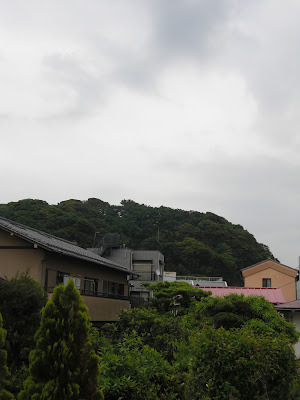
Our plan had been to take a breakfast picnic to the beach and watch the eclipse from there, and, determined, we got out the bicycles...just as the rain began pouring down.
So we leaned out our second story window instead, implored the clouds, waited, and incredibly, the rain ceased, the clouds politely shifted, and there it was...
SUN!
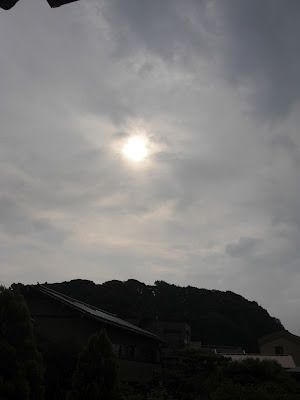
We donned our cool eclipse glasses to see that the moon had turned the sun into a crescent...

and within minutes we had a full annular eclipse--a challenge to photograph without blinding yourself, especially when hanging out a second-story window with eclipse glasses half on.

As the ring turned back to a crescent, we punch a hole in cardboard and projected onto cardboard covered with white paper.
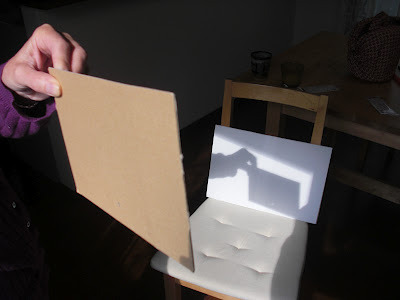
Then punched a few more holes and added the date.
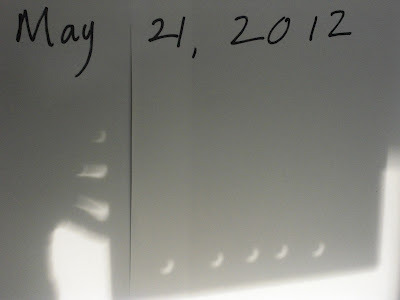
And as the crescent disappeared in the clouds we turned to the breakfast we'd planned to carry to the beach...all wrapped in a furoshiki...
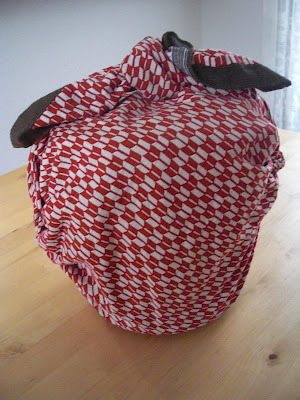
and packed in a laquerware set of round stacking boxes purchased in Kyushu many years ago.

Round foods, in honor of the sun and moon, including fruits...

nikuman steamed buns, hard-boiled eggs and grilled vegetables...

and, of course, sweets: cookies, mushipan steamed cakes, kashiwa mochi sweets wrapped in oak leaves, and mini dorayaki pancakes.
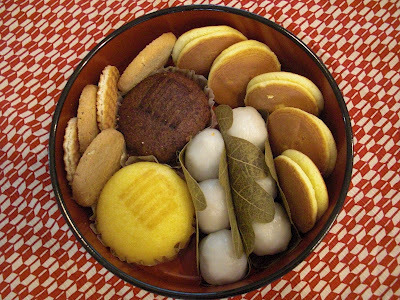
We'd planned to feast at the beach, but it was nice and dry and a lot less sandy just dining at home.
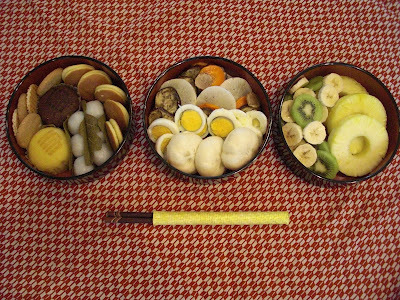
We're so grateful that the clouds parted. The next annular eclipse in Japan isn't until 2030. It would have been a long wait.
But we awoke in Kamakura to...
RAIN!

Our plan had been to take a breakfast picnic to the beach and watch the eclipse from there, and, determined, we got out the bicycles...just as the rain began pouring down.
So we leaned out our second story window instead, implored the clouds, waited, and incredibly, the rain ceased, the clouds politely shifted, and there it was...
SUN!

We donned our cool eclipse glasses to see that the moon had turned the sun into a crescent...

and within minutes we had a full annular eclipse--a challenge to photograph without blinding yourself, especially when hanging out a second-story window with eclipse glasses half on.

As the ring turned back to a crescent, we punch a hole in cardboard and projected onto cardboard covered with white paper.

Then punched a few more holes and added the date.

And as the crescent disappeared in the clouds we turned to the breakfast we'd planned to carry to the beach...all wrapped in a furoshiki...

and packed in a laquerware set of round stacking boxes purchased in Kyushu many years ago.

Round foods, in honor of the sun and moon, including fruits...

nikuman steamed buns, hard-boiled eggs and grilled vegetables...

and, of course, sweets: cookies, mushipan steamed cakes, kashiwa mochi sweets wrapped in oak leaves, and mini dorayaki pancakes.

We'd planned to feast at the beach, but it was nice and dry and a lot less sandy just dining at home.

We're so grateful that the clouds parted. The next annular eclipse in Japan isn't until 2030. It would have been a long wait.
Published on May 20, 2012 17:42
May 17, 2012
Orchards Community Discussion on Teen Bullying and Suicide
On May 22 I will be presenting to adults and teens via Skype from here in Japan at the Palm Beach County Library in Florida for National Mental Health Month. I'll be focusing on Orchards and the tough topics the novel raises on teen bullying and suicide. This is a free program but you need to preregister; details are here. If you're in Florida please help spread the word!



Published on May 17, 2012 20:21
May 16, 2012
Global Voices Part 1: Japanese Picture Books as a Window to Japan
This week PaperTigers.org, the wonderful website that focuses on multicultural books for young readers, world literacy and more, launches a series on the PaperTigers Blog called Global Voices. I was honored to be asked to be the first guest blogger for this new program.
The PaperTigers Blog describes the new Global Voices program: "Each month we will be inviting a guest to join us and write three blog posts. The posts will be published on three consecutive Wednesdays within each month under the title “Global Voices”. Our guests, located around the world, are all involved in the world of kid and YA lit and include award winning authors and illustrators, bloggers, librarians, educators and more! It is our hope that through the Global Voices posts we can better highlight the world of multicultural kid lit and YA lit in different countries around the world."
What a great idea! Up after me are Tarie Sabido of the Philippines and René Colato Laínez of El Salvador and the U.S.
 Monthly books published by Fukuinkan Shoten PublishersMy three-part series to kick off the PaperTigers Global Voices feature has begun! Part 1 of my 3-post series is Japanese Picture Books as a Window to Japan, which includes my thoughts on reading and taking inspiration from Japanese picture books over the years of raising our children and writing here in Japan.
Monthly books published by Fukuinkan Shoten PublishersMy three-part series to kick off the PaperTigers Global Voices feature has begun! Part 1 of my 3-post series is Japanese Picture Books as a Window to Japan, which includes my thoughts on reading and taking inspiration from Japanese picture books over the years of raising our children and writing here in Japan.
This first post in the series also shares my fondness for the monthly books published by Fukuinkan Shoten.
Please have a look at my Global Voices guest post part 1 and post some comments!
Stay tuned for Part 2 of my series on May 23 and Part 3 on May 30 on the PaperTigers Blog.

The PaperTigers Blog describes the new Global Voices program: "Each month we will be inviting a guest to join us and write three blog posts. The posts will be published on three consecutive Wednesdays within each month under the title “Global Voices”. Our guests, located around the world, are all involved in the world of kid and YA lit and include award winning authors and illustrators, bloggers, librarians, educators and more! It is our hope that through the Global Voices posts we can better highlight the world of multicultural kid lit and YA lit in different countries around the world."
What a great idea! Up after me are Tarie Sabido of the Philippines and René Colato Laínez of El Salvador and the U.S.
 Monthly books published by Fukuinkan Shoten PublishersMy three-part series to kick off the PaperTigers Global Voices feature has begun! Part 1 of my 3-post series is Japanese Picture Books as a Window to Japan, which includes my thoughts on reading and taking inspiration from Japanese picture books over the years of raising our children and writing here in Japan.
Monthly books published by Fukuinkan Shoten PublishersMy three-part series to kick off the PaperTigers Global Voices feature has begun! Part 1 of my 3-post series is Japanese Picture Books as a Window to Japan, which includes my thoughts on reading and taking inspiration from Japanese picture books over the years of raising our children and writing here in Japan.This first post in the series also shares my fondness for the monthly books published by Fukuinkan Shoten.
Please have a look at my Global Voices guest post part 1 and post some comments!
Stay tuned for Part 2 of my series on May 23 and Part 3 on May 30 on the PaperTigers Blog.
Published on May 16, 2012 22:40
May 9, 2012
Exercising to Write--with a Kamakura Hike
For me a good writing day includes a run or hike. I'm always better able to focus on my work after exercise. At the moment I'm challenging myself with completing a first full draft of a middle-grade novel by the end of this month. So of course, on this beautiful May morning, I needed a good hike to get the ideas flowing.
I started with a vigorous hike in the Kamakura hills then meandered a bit and wound up ducking into a few temples. A few photos of my meanderings:
 Toshojibashi--bridge over the Namerigawa
Toshojibashi--bridge over the Namerigawa
 Hokaiji
Hokaiji
 Hokaiji
Hokaiji
 Genpei pond at Hachimangu
Genpei pond at Hachimangu
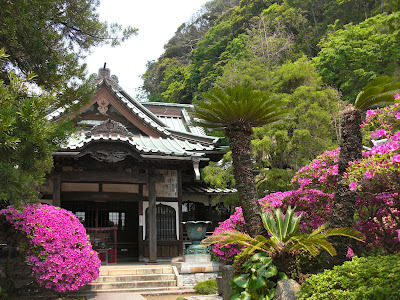 Anyoin
Anyoin
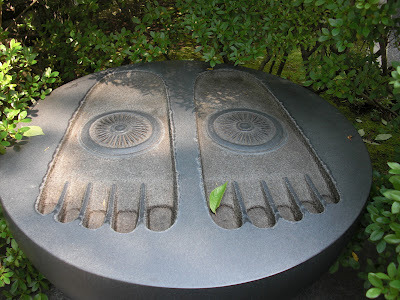 Buddha's footprints at Anyoin
Buddha's footprints at Anyoin
 Wall of azaleas at Anyoin
Wall of azaleas at Anyoin
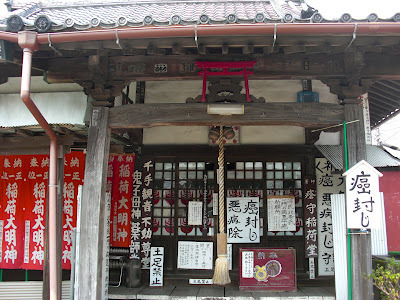 Shrine within Jogyoji
Shrine within Jogyoji
So now that I'm re-energized, it's back to the writing.

I started with a vigorous hike in the Kamakura hills then meandered a bit and wound up ducking into a few temples. A few photos of my meanderings:
 Toshojibashi--bridge over the Namerigawa
Toshojibashi--bridge over the Namerigawa
 Hokaiji
Hokaiji Hokaiji
Hokaiji Genpei pond at Hachimangu
Genpei pond at Hachimangu Anyoin
Anyoin Buddha's footprints at Anyoin
Buddha's footprints at Anyoin Wall of azaleas at Anyoin
Wall of azaleas at Anyoin Shrine within Jogyoji
Shrine within JogyojiSo now that I'm re-energized, it's back to the writing.
Published on May 09, 2012 20:16
April 30, 2012
After the Verse Novel Revisions
For the past several weeks I've been immersed in the revisions and edits of my latest verse novel. Intense, exhausting revisions. Adding, cutting, adjusting, distilling, rebreaking, adding, cutting, adjusting, distilling . . .

And in the midst of my revisions I received feedback from several key readers advising me on particular details or plot points, meaning that I had to unravel chapters and knit them back together, and deftly weave in elements that had been missing.
Some people have the impression that verse novels are easier to write than prose novels. But verse novels are not just broken prose. In a verse novel all that white space needs to carry meaning. Scenes and details off the page balance the story on the page. Each line break needs to be thought and rethought. Every word needs to sing, yet sing in the voice of the narrator. Dialogue needs to somehow sound natural, and poetic elements need to be nearly invisible so as not to outshine the story. Each page turn matters, and each chapter must add up to a full poem unit. Some days I long for the long-striding ease of prose.
Revision is a mind-bending, exhausting but essential process of discovery. At the end of each day of "final" revisions, you are closer to your story and your characters than you have been in all the months prior of drafting and revising. Your characters seem to inhabit you. You eat breakfast with them. You jog with them. You ask them what they want for dinner.
So after finally emailing the manuscript to my editor and agent, I felt the ache of a farewell. Relief but sadness. My office suddenly felt empty of the voices I'd been so intently striving to hear for the last few weeks.
Of course within 36 hours of pressing the send button, I had the requisite post-stress, massive migraine. A recovery day was in order. Kamakura was crazy crowded yesterday, the first Sunday of Golden week, but on a bike it's easy to find quiet temples away from the hoards.
So here are a few quiet post-revision photos:
 Kaizoji
Kaizoji
 Kaizoji
Kaizoji
 Private garden
Private garden
 Myohoji
Myohoji
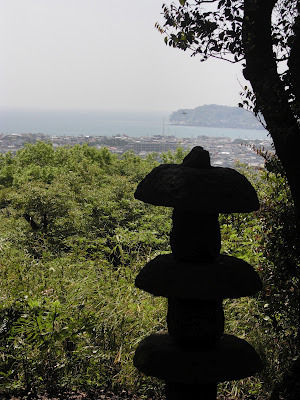 View from the hill behind MyohojiSo now I can catch up with projects abandoned during the intense revising weeks, and get to work on . . . another novel, with another set of characters and new voices to inhabit my office.
View from the hill behind MyohojiSo now I can catch up with projects abandoned during the intense revising weeks, and get to work on . . . another novel, with another set of characters and new voices to inhabit my office.

And in the midst of my revisions I received feedback from several key readers advising me on particular details or plot points, meaning that I had to unravel chapters and knit them back together, and deftly weave in elements that had been missing.
Some people have the impression that verse novels are easier to write than prose novels. But verse novels are not just broken prose. In a verse novel all that white space needs to carry meaning. Scenes and details off the page balance the story on the page. Each line break needs to be thought and rethought. Every word needs to sing, yet sing in the voice of the narrator. Dialogue needs to somehow sound natural, and poetic elements need to be nearly invisible so as not to outshine the story. Each page turn matters, and each chapter must add up to a full poem unit. Some days I long for the long-striding ease of prose.
Revision is a mind-bending, exhausting but essential process of discovery. At the end of each day of "final" revisions, you are closer to your story and your characters than you have been in all the months prior of drafting and revising. Your characters seem to inhabit you. You eat breakfast with them. You jog with them. You ask them what they want for dinner.
So after finally emailing the manuscript to my editor and agent, I felt the ache of a farewell. Relief but sadness. My office suddenly felt empty of the voices I'd been so intently striving to hear for the last few weeks.
Of course within 36 hours of pressing the send button, I had the requisite post-stress, massive migraine. A recovery day was in order. Kamakura was crazy crowded yesterday, the first Sunday of Golden week, but on a bike it's easy to find quiet temples away from the hoards.
So here are a few quiet post-revision photos:
 Kaizoji
Kaizoji
 Kaizoji
Kaizoji
 Private garden
Private garden
 Myohoji
Myohoji
 View from the hill behind MyohojiSo now I can catch up with projects abandoned during the intense revising weeks, and get to work on . . . another novel, with another set of characters and new voices to inhabit my office.
View from the hill behind MyohojiSo now I can catch up with projects abandoned during the intense revising weeks, and get to work on . . . another novel, with another set of characters and new voices to inhabit my office.
Published on April 30, 2012 00:09



